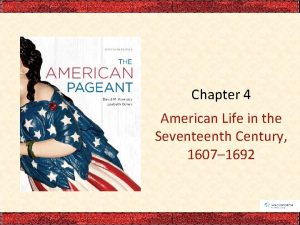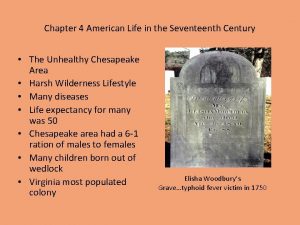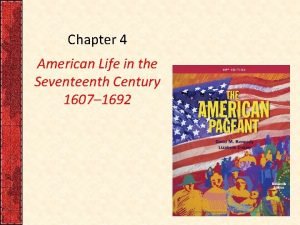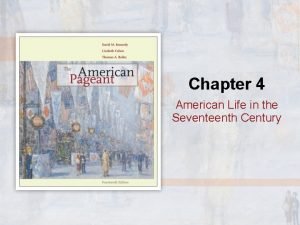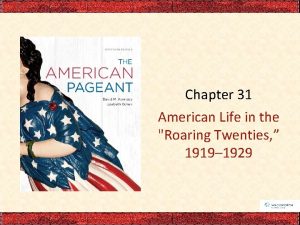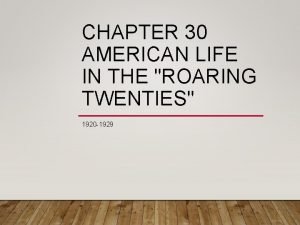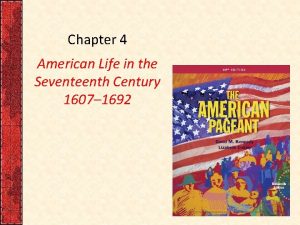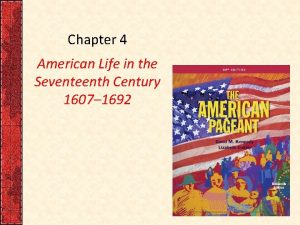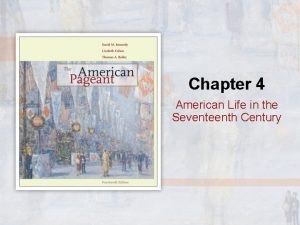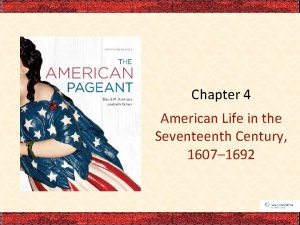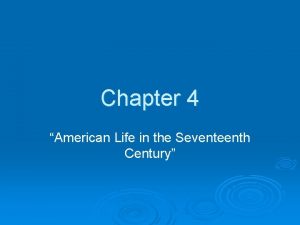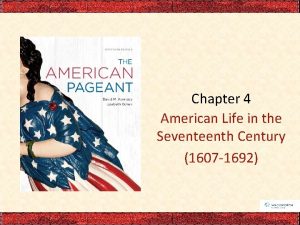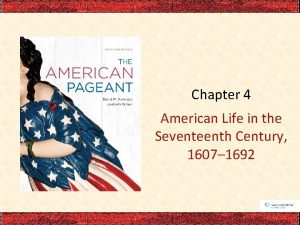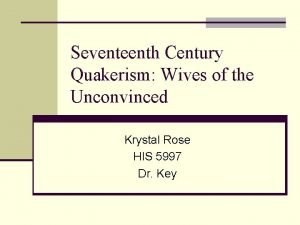Chapter 4 American Life in the Seventeenth Century






































- Slides: 38

Chapter 4 American Life in the Seventeenth Century, 1607– 1692

The Unhealthy Chesapeake • Malaria, Dysentery and Typhoid took a cruel toll on the Chesapeake settlers, cutting ten years off the life expectancy of newcomers from England. – The Great Majority of immigrants were single men in their late teens. – Most died after arrival. – Surviving males competed for the attentions of the extremely scarce women which the men outnumbered 6: 1. • Yet despite hardships, the Chesapeake colonies struggled on. – The native-born in habitants eventually acquired immunity to killer diseases. – The presence of a few women allowed some families to form.

The Tobacco Economy • The Chesapeake was hospitable to tobacco cultivation. – Relentless seeking of fresh fields to plant tobacco made settlers plunge even farther up river valleys provoking Indian attacks. 1. 5 million pounds of tobacco annually came out of the Chesapeake Bay. • Indentured servants were willing to be slaves for a few years in order for someone to pay their transatlantic trip. – At the end they’d receive their freedom dues which included food, some tools and a small parcel of land.

p 61

The Tobacco Economy • Several colonies practiced the Headright System which granted 50 acres of land to whoever paid the passage of a laborer to America. – Ravenous for labor and land the Chesapeake planters brought some 100, 000 indentured servants to the region by 1700’s. – As land became scarcer, poor freed workers had to hire themselves out for pitiful wages back to their former masters.

p 63

Frustrated Freemen and Bacon’s Rebellion • Virginia’s governor William Berkley had to deal with one thousand Virginians rebelling out of control in 1676. – The rioters were led by 29 - year old Nathaniel Bacon. – They fiercely resented Berkley’s friendly politics towards the Indians. Especially when Berkley refused to retaliate against a series of brutal Indian attacks on frontier settlements. – Bacon and his followers murdered the Indians, chased Berkley from Jamestown and set fire to the capital. – Eventually Berkley hung 20 rebels and Bacon died of disease. – This led many landowners to turn away from the use of indentured servants and towards slave labor.

Leisler’s Rebellion • In New York the animosity between lordly landholders and aspiring merchants fueled Leister’s Rebellion from 16891691. • When King James II was dethroned and replaced by King William of the Netherlands, the colonists of New York rebelled and made Jacob Leisler, a militia officer, governor of New York. • Leisler was hanged for treason when royal authority was reinstated in 1691, but the representative assembly which he founded remained part of the government of New York.

Colonial Slavery • More than 7 million Africans were carried in chains to the New World in the 3 centuries following Columbus’s landing. – By 1700 about 400, 000 had ended up in North America.

Colonial Slavery • In 1680 the rising wages in England shrank the pool of penniless folk willing to gamble a new life or an early death as an indentured servant in America. • In 1698 the Royal African Company lost its crown granted monopoly on carrying slaves to the colonies. – Enterprising Americans, especially Rhode Islanders rushed in to cash in on the lucrative slave trade and the supply of slaves rose steeply.

p 68

Colonial Slavery • The captives, usually branded and bound, were herded aboard sweltering ships for the tiresome middle passage. – Death rates ran as high as 20 percent. – Slaves were then sent to slave auctions in the new world ports, where a giant slave market traded in human life and misery for a century. • “Slave Codes” made blacks and their children the property of their white masters for life. – Some colonies made it a crime to teach a slave to read or write. Not even a conversion to Christianity could qualify a slave for freedom.

p 65

Map 4 -1 p 65

Africans in America • In the deepest south the climate was hostile to health and the labor was life-draining. – There were rice and indigo plantations in South Carolina with far distances in between known for being lonely hells on earth. – Blacks in the tobacco-growing industry were somewhat better off because tobacco was a less physically demanding crop.

p 67

Africans in America • Native born African Americans contributed to the growth of a stable and distinctive slave culture- a mixture of African and American religion, speech and folkways. – Around South Carolina blacks evolved a unique language called Gullah (a mix of English with African languages). – Some African words have even been passed into American speech- Goober (peanut), gumbo (okra) and voodoo (witchcraft).

p 69

Southern Society • The rich planters were at the top of society. – They had wealth, prestige and political power. – Beneath them were the small farmers who made up the largest social group. Then came the ex-indentured slaves, then the people still serving out their indenture. The bottoms of the bottom were the black slaves and they slowly replaced the indentured slaves.

p 70

Southern Society • Southern life revolved around the great plantations. – Waterways provided the principal means of transportation. – Roads were so wretched in bad weather that sometimes funeral parties couldn’t reach church burial grounds- an obstacle that accounted for the development of family burial plots.

Southern Society • In 1712 there was a slave revolt in New York City that killed 9 whites and injured many others. 21 slaves were executed once the revolt was controlled. – In 1739 there was another slave revolt where 50 blacks tried marching along to Spanish Florida from South Carolina called the Stono Rebellion; they were stopped by the militia.

The New England Family • Clean water and cool temperatures retarded the spread of killer microbes in the New England area. – In contrast to the Chesapeake, New England settlers added ten years to their life spans by migrating from the old world. The average life span was 70 years. • They also tended to migrate as families instead of lone men. So the population grew more swiftly from natural reproduction. – Early marriage also encouraged the booming birthrates A married woman could expect up to 10 pregnancies and rear as many as 8 surviving children.

p 71

The New England Family • The fragility of Southern families boosted the economic security of the southern women -- especially in women’s property rights because southern men frequently died young, leaving widows with small children to support. – The southern colonies generally allowed married women to retain separate properties and gave widows the right to inherit their husband’s estates. • In the 17 th century a rudimentary conception of woman’s rights as individuals was beginning to appear. – Women still couldn’t vote and popular attitude insisted that they were morally weaker. • The laws of Puritan New England sought to defend the integrity of marriages. Divorce was exceedingly rare and the authorities would sometimes order separated couples to reunite.

Life in the New England Towns • Proprietors were the sober-minded town fathers. – New towns were legally chartered by colonial authorities and the distribution of land was entrusted to the laws of proprietors. – The center usually consisted of a meetinghouse which doubled as a place of worship and a town hall. • Towns of more than 50 families were required to provide elementary education. Half the adults were literate. – In 1636 - Harvard College was established in Massachusetts. In 1693 the College of William and Mary in Virginia was established. • Puritans ran their church democratically and that led to democratic government.

The Half-Way Covenant and the Salem Witch Trials • Jeremiad- Often fiery sermon that lamented the waning piety of parishioners. • There was a decline of conversions and in 1662 the “Halfway Covenant” was established. – It modified the original Puritan covenant to admit baptism but not full communion of the children of baptized but not yet converted existing members. • It was meant to increase church membership and community involvement, but it came at a great price to Puritan society.

The Half-Way Covenant and the Salem Witchcraft Trials • The Half-Way Covenant weakened the distinction between the elect and others. • A group of adolescent girls in Salem, Massachusetts claimed to have been bewitched by certain older women, leading to The Salem Witchcraft trials. – 19 individuals hanged, one was pressed to death and two dogs killed. – The Trials ended in 1693 when the governor was alarmed by the accusations against his wife. The term “witch hunting” developed into a metaphor for the dangerously irrational urge to find a scapegoat for social resentments.

p 74

The New England Way of Life • The climate was uncomfortably hot in the summers and the winter was cruelly cold. • Rocky soil forced the New Englanders to work hard, be industrious and frugal. – They turned to the ports, and fishing became the “gold mine” of New England. • The Americans thought that the natives “wasted land” by not doing anything on it.

The Early Settlers’ Days and Ways • Each member of the family did their jobs. Life was humble but comfortable and land was cheap. – Women, whether they were slaves or free or worked on southern plantations or in the north had similar duties all over. – They wove, cooked, cleaned and cared for children. – The men cleared land, fenced planted and cropped it, cut firewood and butchered livestock as needed. – The children helped with all these tasks while picking up as much schooling as they could.

p 76

p 77

p 72

p 68

p 73

p 63

p 66
 Chapter 4 american life in the seventeenth century
Chapter 4 american life in the seventeenth century American life in the seventeenth century
American life in the seventeenth century Chapter 4 american life in the seventeenth century
Chapter 4 american life in the seventeenth century Chapter 4 american life in the seventeenth century
Chapter 4 american life in the seventeenth century Summer of the seventeenth doll summary
Summer of the seventeenth doll summary Principles of marketing chapter 2
Principles of marketing chapter 2 Chapter 31 american life in the roaring twenties
Chapter 31 american life in the roaring twenties Chapter 30 american life in the roaring twenties
Chapter 30 american life in the roaring twenties The worlds of the fifteenth century
The worlds of the fifteenth century The worlds of the fifteenth century
The worlds of the fifteenth century Chapter 8 recording adjusting and closing entries
Chapter 8 recording adjusting and closing entries 1. 5-1 work together, p. 128
1. 5-1 work together, p. 128 Hình ảnh bộ gõ cơ thể búng tay
Hình ảnh bộ gõ cơ thể búng tay Bổ thể
Bổ thể Tỉ lệ cơ thể trẻ em
Tỉ lệ cơ thể trẻ em Chó sói
Chó sói Glasgow thang điểm
Glasgow thang điểm Alleluia hat len nguoi oi
Alleluia hat len nguoi oi Kể tên các môn thể thao
Kể tên các môn thể thao Thế nào là hệ số cao nhất
Thế nào là hệ số cao nhất Các châu lục và đại dương trên thế giới
Các châu lục và đại dương trên thế giới Công thức tính thế năng
Công thức tính thế năng Trời xanh đây là của chúng ta thể thơ
Trời xanh đây là của chúng ta thể thơ Mật thư anh em như thể tay chân
Mật thư anh em như thể tay chân Phép trừ bù
Phép trừ bù Phản ứng thế ankan
Phản ứng thế ankan Các châu lục và đại dương trên thế giới
Các châu lục và đại dương trên thế giới Thể thơ truyền thống
Thể thơ truyền thống Quá trình desamine hóa có thể tạo ra
Quá trình desamine hóa có thể tạo ra Một số thể thơ truyền thống
Một số thể thơ truyền thống Cái miệng bé xinh thế chỉ nói điều hay thôi
Cái miệng bé xinh thế chỉ nói điều hay thôi Vẽ hình chiếu vuông góc của vật thể sau
Vẽ hình chiếu vuông góc của vật thể sau Nguyên nhân của sự mỏi cơ sinh 8
Nguyên nhân của sự mỏi cơ sinh 8 đặc điểm cơ thể của người tối cổ
đặc điểm cơ thể của người tối cổ Ví dụ về giọng cùng tên
Ví dụ về giọng cùng tên Vẽ hình chiếu đứng bằng cạnh của vật thể
Vẽ hình chiếu đứng bằng cạnh của vật thể Tia chieu sa te
Tia chieu sa te Thẻ vin
Thẻ vin
